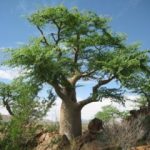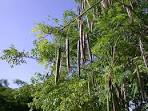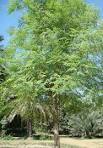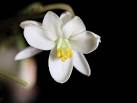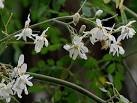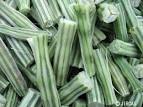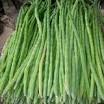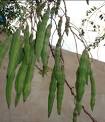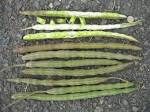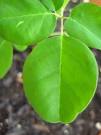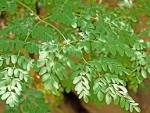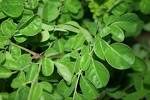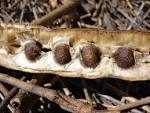Moringa oleifera
Uses
India (Rajasthan, western): flowers, leaves, leaf buds and long fruit (‘drum sticks’) eaten as vegetable. Sudan: small leaflets are stripped from the leaf stalks and eaten raw in salads. Young pods eaten like green beans and the flowers and leaves are eaten as vegetables. The green or dried leaves eaten as salad mixed with groundnuts, or cooked as a stew and served with porridge or Kisra (a thin, flat bread). Nigeria (Kano State, northern): leaves, roots, young pods, seed oil eaten. Niger (Balayera. Zinder). Leaves used primarily as a condiment and in soups. Contains high amounts of calcium and βcarotenoids. Protein content = 22.9%. Niger leaf sample indicates protein content =17.1% For comprehensive data on nutrient values, see FREIBERGER.
Additional Information
- Name Authority:
- Lam.
- Vernaculars:
- Rajasthan: Sainjan, Sanjna. Madhya Pradesh (Hindi dialect): Sehjana. Sudan (Arabic): Rawag. English: Drumstick Tree. Hausa: Zogale. Kanuri: Alinga zogola, gandi
- Misc:
- Chemical composition (after Abdelmuti): Protein (crude) = 15.6% (dry). Fat = 10.1% (dry). Fibre (crude) = 5.1% (dry). Ash = 11.5% (dry). Carbohydrate (soluble): Starch = 5.1% (dry). Sucrose = 5.5% (dry). D-glucose = 1.3% (dry). F-fructose = 1.5% (dry). Amino acids (g [16g N]-1): Aspartic acid = 10.4g. Threonine = 5.3g. Serine = 4.7g. Glutamic acid = 13.3g. Proline = 4.4g. Glycine = 6.4g. Alanine = 7.3g. Valine = 6.8g. Cysteine = 0.8g. Methionine = 1.8g. Isoleucine = 5.6g. Leucine = 10.9g. Tyrosine = 4.7g. Phenylalanine = 6.6g. Lysine = 6.1g. Histidine = 2.4g. Arginine = 6.6g. Minerals: Sulphur = 0.23% (dry). Postassium = 0.14% (dry). Magnesium = 0.69% (dry). Calcium = 3.18% (dry). Na = 0.16% (dry). K =0.91% (dry). Zinc = 15mg/kg-1 (dry). Iron = 854mg/kg -1 (dry). Manganese = 79mg/kg-1 (dry). Copper = 5mg/kg-1 (dry). Leaves rich in Vitamins A and C. See also Jain & Tiwari
